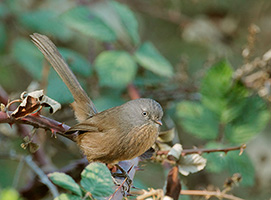 |
Wrentit
Chamaea fasciata |
|
|
STANFORD LOCATIONS: Uncommon, very secretive resident in dense, brushy vegetation. Sparsely distributed on main campus but more common and widespread in scrub near the Dish and around faculty housing. |
 |
Location |
Type |
Mating System |
Parental Care |
2ndary Diet |
Strategy |
|
|
|
|
I: 15-16 DAYS ALTRICIAL |
|
|
|
|
|
(3-5) MONOG |
MF |
|
| BREEDING: | Chaparral, scrub, well planted suburban areas. 2? broods. |
| DISPLAYS: | ? |
| NEST: | Base of cobwebs supporting coarse bark, with deep cup of fine bark, lined with fine fibers, hair. Outside often decorated with lichen. |
| EGGS: | Pale greenish-blue, unmarked. 0.7" (18 mm). |
| DIET: | Includes spiders; adults feed heavily on fruit, esp when insects scarce in fall and winter. Young fed 100% insects. |
| CONSERVATION: | Winter resident. Uncommon cowbird host. |
| NOTES: | "Bouncing ping pong ball" song is heard much more often than bird is seen; secretive in thick undergrowth. Extremely sedentary: mate for life and remain in 1 -- 2.5 --acre area. Young still beg from adults at 30-35 days. Tends to avoid singing when Bewick's Wrens sing (so as to avoid acoustic interference); usu follows wren by few minutes. Recent taxonomic work indicates neither a wren nor a tit (as chickadees are called in England), but a babbler (Timaliidae), an otherwise Old World family of insectivores. |
| ESSAYS: | Birds, DNA and Evolutionary Convergence; DNA and Classification; Bathing and Dusting. |
| REFERENCES: | Fleischer et al., 1985; Sibley and Ahlquist, 1984b. |
| Help | Abbreviations | Species-Alphabetical | Species-Taxonomic | Essays-Alphabetical | |
| Except for Stanford Locations, the material in this species treatment is taken, with permission, from The Birder's Handbook (Paul Ehrlich, David Dobkin, & Darryl Wheye, Simon & Schuster, NY. 1988). | |||||